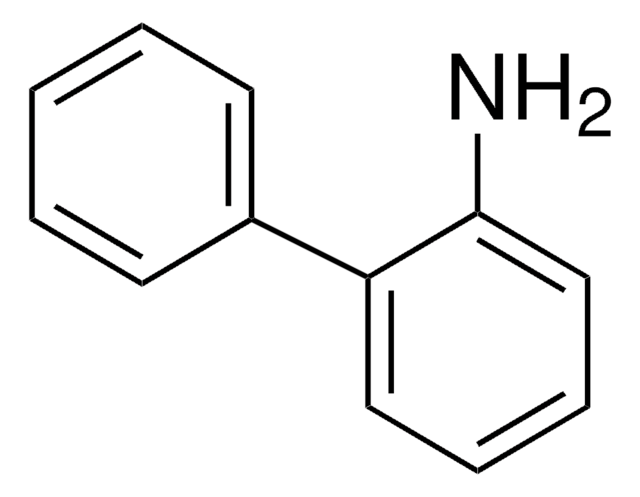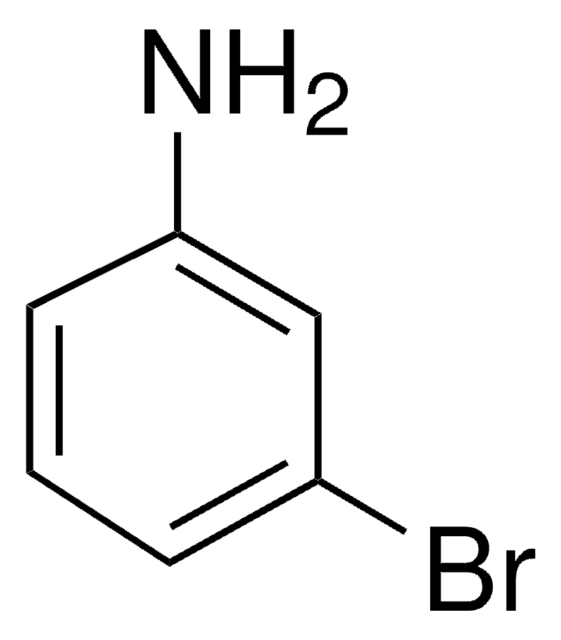All Photos(1)
About This Item
Empirical Formula (Hill Notation):
C12H11N
CAS Number:
Molecular Weight:
169.22
MDL number:
UNSPSC Code:
12352100
PubChem Substance ID:
NACRES:
NA.22
Recommended Products
Assay
97%
form
solid
mp
28-33 °C
SMILES string
Nc1cccc(c1)-c2ccccc2
InChI
1S/C12H11N/c13-12-8-4-7-11(9-12)10-5-2-1-3-6-10/h1-9H,13H2
InChI key
MUNOBADFTHUUFG-UHFFFAOYSA-N
Signal Word
Warning
Hazard Statements
Precautionary Statements
Hazard Classifications
Acute Tox. 4 Oral - Eye Irrit. 2 - Skin Irrit. 2 - STOT SE 3
Target Organs
Respiratory system
Storage Class Code
11 - Combustible Solids
WGK
WGK 3
Flash Point(F)
>230.0 °F - closed cup
Flash Point(C)
> 110 °C - closed cup
Certificates of Analysis (COA)
Search for Certificates of Analysis (COA) by entering the products Lot/Batch Number. Lot and Batch Numbers can be found on a product’s label following the words ‘Lot’ or ‘Batch’.
Already Own This Product?
Find documentation for the products that you have recently purchased in the Document Library.
Customers Also Viewed
J W Gorrod et al.
Anticancer research, 6(4), 729-731 (1986-07-01)
The metabolism of 3-aminobiphenyl (3-ABP) and 3-acetamidobiphenyl (3-AABP) has been studied using fortified rat liver microsomal preparations. Metabolites in concentrates of ether extracts from hepatic microsomal preparations were analysed by TLC and GLC. The metabolites were characterised by a comparison
M Kajbaf et al.
European journal of drug metabolism and pharmacokinetics, 12(4), 285-290 (1987-10-01)
[14C] 2-Aminobiphenyl is predominantly metabolised in vivo to 3- and 5-hydroxy conjugated derivatives in all species. In some species, 2-aminobiphenyl is also excreted to a small extent as N-conjugated derivatives. Renal excretion accounts for about 30-40% of the administered dose
J Esteban Castelao et al.
International journal of cancer, 110(3), 417-423 (2004-04-20)
Previous epidemiological studies of fruit and vegetable intake and bladder cancer risk have yielded inconsistent results, especially with respect to the role of cigarette smoking as a possible modifier of the diet-bladder cancer association. A population-based case-control study was conducted
Mohamadi Sarkar et al.
Toxicology and applied pharmacology, 213(3), 198-206 (2006-01-13)
Some aromatic amines are considered to be putative bladder carcinogens. Hemoglobin (Hb) adducts of 3-aminobiphenyl (3-ABP) and 4-aminobiphenyl (4-ABP) have been used as biomarkers of exposure to aromatic amines from cigarette smoke. One of the goals of this study was
G Ronco et al.
British journal of cancer, 61(4), 534-537 (1990-04-01)
In a previous study we found that aromatic amines, particularly 4-aminobiphenyl, formed haemoglobin adducts at higher concentrations in the blood of smokers compared to non-smokers. We re-analyse here data on haemoglobin adducts of 14 aromatic amines in order to ascertain
Our team of scientists has experience in all areas of research including Life Science, Material Science, Chemical Synthesis, Chromatography, Analytical and many others.
Contact Technical Service











